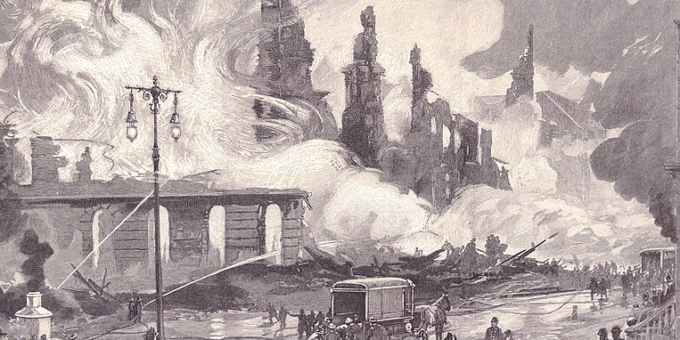
The Windsor Hotel was built in Manhattan, New York in 1873. It was a luxury hotel for the rich and elite who preferred to lived in hotels. Located at 575 Fifth Avenue, the seven-story hotel was built before fire stops and other fire safety measures became mandated.
On St. Patrick’s day, March 17, 1899, people were standing outside to watch the parade go by. There were people watching through the hotel’s windows and, it was reported, there were a few employees on the roof of the hotel.
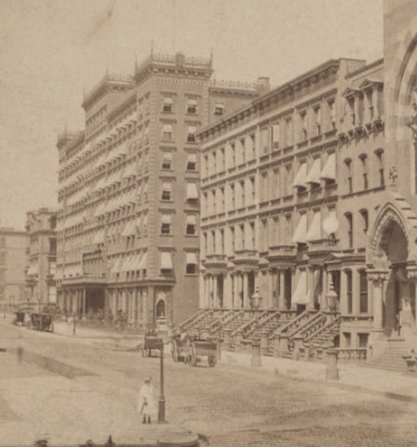
Suddenly, a little after 3 pm, a fire started inside the hotel and the hotel burned down in 90 minutes.
Firemen who were in the parade rushed to help people escape from the burning hotel, but the streets were crowded and the fire was burning hot and fast. People threw themselves out of the windows and from the roof, only to die on impact below.
About 90 people are believed to have died in the fire. 31 of the bodies could not be identified.
It was rumored that the fire started after someone stepped out onto one of the hotel’s balconies, lit a cigarette, and tossed the match. The wind blew the lit match into a window and curtains lit on fire. It was also believed that the fire might have been started by thieves as a means of distraction.
It’s estimated that it only took ten minutes before the fire was at a full roar and all means of escaping the building, from the stairways to the elevator, were blocked off by fire and heavy smoke.
Fire Escapes
Why did so many people die that day? According to Building Inspector Bunnell:
“It was an old building, built many years ago. The rapidity with which the flames spread was due to the fact that the building was not fire proof. There were no fire proof steps in the corridors, such as are required in all modern buildings, and the corridors were swept by a great draft that went through them. How many fire escapes were there? Why, the rear and sides of the building were literally covered with them, and ropes were in every room. As is usually the case, the people were frantic from fear and did not know enough to use the escapes.”
The Rope Escape
Edward P. Wells, his wife, and daughter, were on the sixth floor of the Windsor Hotel when the fire broke out. They had been watching the St. Patrick’s parade from their window when smoke began entering their room from the corridor.
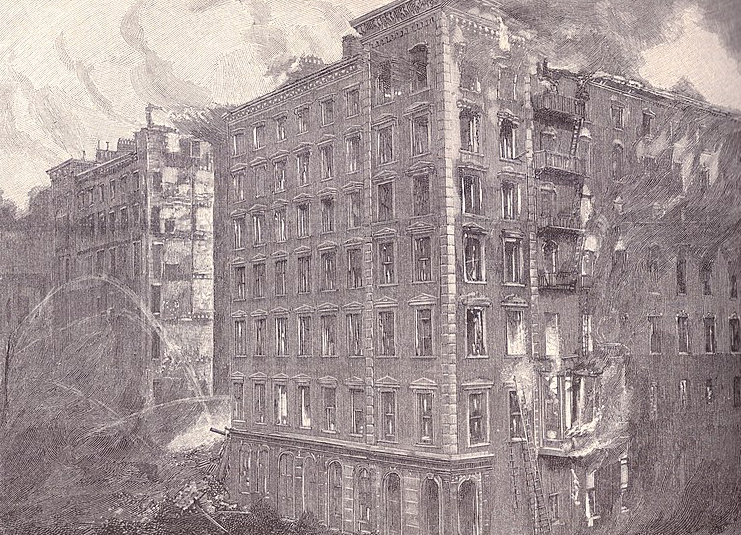
They were completely cut off from the stairs and fire escapes, so Mr. Wells had to think fast.
Their only escape was through the window, but there was no way they could survive the jump.
Mr. Wells uncoiled the rope that was in each room of the hotel. He tied one end around his daughter’s waist and slowly lowered her down to the street. When she reached the ground, firemen untied her and Mr. Wells pulled the rope back up.
He did the same thing for his wife, and after she was safely received, he pulled the rope back up for a second time.
With his family safe, he had to find a way to get down the rope without falling or destroying his hands from rope burn. He grabbed some towels and wrapped them around his hands. He grabbed the rope, climbed out the window, and shot straight down to the ground where men waited to break his fall.
The firemen undid his bandaged hands and, to everyone’s surprise, Mr. Wells hands were in perfect condition.
Many of those who were able to escape using a rope had severely burned hands. Some could not hold on to the rope until they reached the ground and had to let go. Several of those who had let go survived the initial fall and were taken away to makeshift hospitals to receive care for broken bones and internal injuries.
Jumped
Newspapers published the names of the deceased as they were identified. However, there were numerous bodies that were never given a name. Here is a clip from one list published the day after the fire:
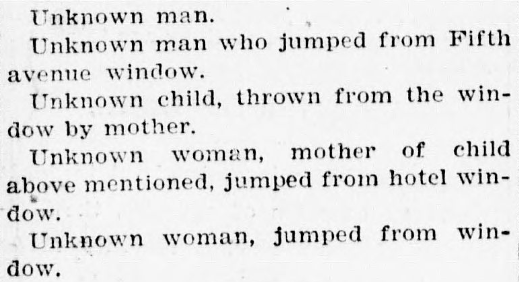
One woman who jumped from her window landed on the hotel railing. One eye witness account said:
“The first horror occurred just 15 minutes after the fire broke out. A handsome woman appeared at the window of a room on the fourth floor. She held out her arms to the crowd below. Then she raised her hands as if in supplication, and in a moment climbed to the window and leaped. She turned about like a top and struck the iron railing in front of the hotel. Her body seemed to be impaled there, but fell off and into the area way. She was dead.”
Scaling Ladders
As soon as the firemen could, they set up their scaling ladders and climbed up the sides of the building. This allowed them to rescue a few of the people trapped on the lower floors, but there was no hope for those trapped on the 6th and 7th floors.
An elderly woman was rescued from the 5th floor. It was reported that:
“One of the most daring rescues effected by the firemen occurred on the fifth floor on the 5th avenue front. An elderly woman was seen at a window and two firemen succeeded in reaching the window immediately underneath. One of them climbed to the coping of the window on which she was standing and then swung the woman clear of the window and landed her safe in the arms of his companion, who with the assistance of several other firemen, passed her down to the street.”
There were plenty of other daring rescues that day. Another eyewitness account said:
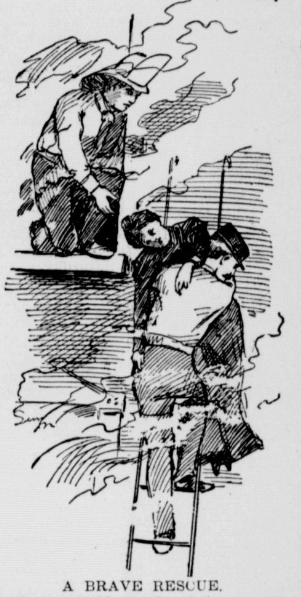
“In one instance a fireman at the top of a scaling ladder was 12 feet or more short of a young woman standing in a window, through which smoke was pouring. It was out of the question to reach her, as the ladder was extended to the limit. The man stood upright on the top of a rung, steadied himself by placing one hand against the hot wall, and told the woman to hang out of the window by her hands. When she had done this she was still 4 feet above him. The man hesitated and then told the woman to drop. She alighted astride his shoulders, nearly causing him to lose balance, but, after wavering for a moment, 60 feet above the ground, he recovered his equilibrium and carried the woman down the ladder.”
Putting Out the Fire
Three fire engines and a hundred firemen worked through the night to put the fire out. They had six streams of water pouring onto the flames and eventually the remains of the hotel began to smoke and steam.
The day after the fire had started, rescuers and wreckers were able to start removing the debris and search for missing bodies. 200 men began removing bricks and twisted iron. There was no hope in finding any survivors.
Charred Remains
Bodies were still being found in the remains of the hotel five days after the fire. None of these charred bodies and body parts could be properly identified.

On March 22, it was reported that:
“The remains of another body were found on the 5th Avenue side of the ruins. It consisted of a mass of charred intestines. Beside this mass was a thigh bone from which all the flesh had been burned. Near this was another bone, but it could not be told to what part of the body it belonged.”
“The fifth body to be recovered was taken out of the ruins on the southwest corner. It was a charred trunk with the legs below the knees and the arms below the elbows missing. The upper part of the head was also missing. Opinions differ as to whether it is the body of a man or woman, but it was thought to be the latter. Nothing was found near the trunk by which it might be identified.”
A spinal column with some ribs attached was uncovered as well as a charred foot near the elevator shaft. The bones of a forearm were uncovered on the 23rd, but there was absolutely nothing else left to identify these remains.
Lasting Effect
The effects of the Windsor Hotel fire were felt long after the last body part was removed from the rubble.
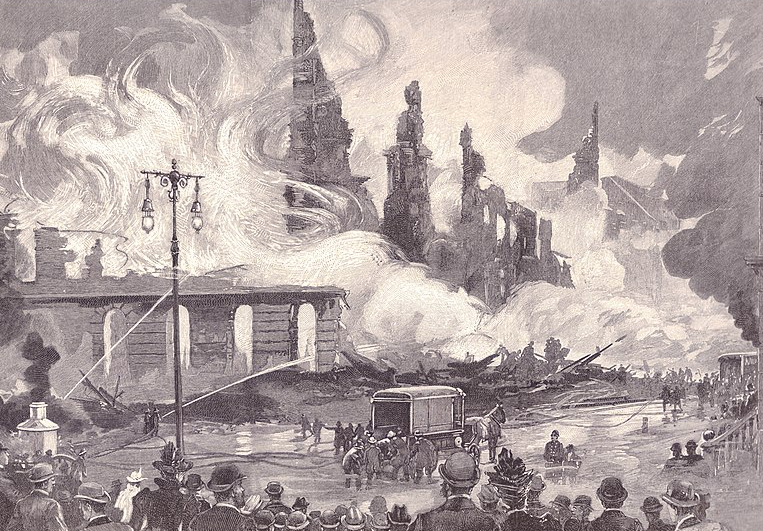
Warren Leland, the hotel’s proprietor, had lost both his wife and daughter in the fire. Less than a month later, he died after receiving an operation for appendicitis.
Dorothy Wheeler, who was seriously burned in the hotel fire, passed away nearly four months later.
In 1902, it was announced that Katherine Craig married the man who carried her to safety in the Windsor Hotel fire.
And years later, in 1914, Baby, an ambulance horse, was mourned by the people of New York City. She had pulled the ambulances to the Windsor Hotel fire, as well as to the Park Avenue Hotel fire and the Triangle Shirtwaist Company fire.

